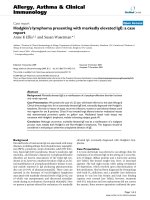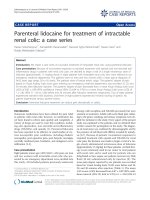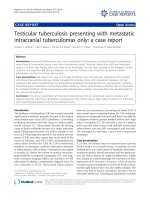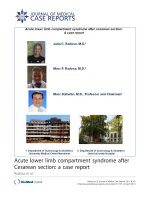Báo cáo y học: " Alveolar soft part sarcoma of the tongue in a 3-year-old boy: a case report" pptx
Bạn đang xem bản rút gọn của tài liệu. Xem và tải ngay bản đầy đủ của tài liệu tại đây (656.44 KB, 4 trang )
JOURNAL OF MEDICAL
CASE REPORTS
Noussios et al. Journal of Medical Case Reports 2010, 4:130
/>Open Access
CASE REPORT
BioMed Central
© 2010 Noussios et al; licensee BioMed Central Ltd. This is an Open Access article distributed under the terms of the Creative Commons
Attribution License ( which permits unrestricted use, distribution, and reproduction in
any medium, provided the original work is properly cited.
Case report
Alveolar soft part sarcoma of the tongue in a
3-year-old boy: a case report
George Noussios*
1,2
, Pantelis Chouridis
1
, Ioannis Petropoulos
1
, Kostas Karagiannidis
1
and George Kontzoglou
1
Abstract
Introduction: Alveolar soft tissue sarcoma of the tongue is a very rare and aggressive tumor which occurs in infancy
with a relatively controversial histogenesis. It may mimic benign vascular neoplasms and may metastasize to the lungs,
brain or bones.
Case presentation: We present the case of a three-year-old Caucasian boy who was admitted to our department with
a history of dysphagia and two episodes of oral bleeding which had lasted for a period of six months. A thorough
histological examination together with imaging techniques form the basis of a reliable diagnosis.
Conclusion: Alveolar soft tissue sarcoma of the tongue is a rare tumor which occurs in infancy and which is often
misdiagnosed pre-operatively. It should therefore be included in the differential diagnosis of oral pediatric lesions.
Introduction
Alveolar soft part sarcoma of the tongue (ASPS) is a rare
and aggressive malignancy which comprises 0.4% to 1.0%
of all soft tissue sarcomas. It accounts for up to 5% of all
pediatric soft tissue sarcomas, apart from rhabdomyosar-
comas [1]. In infants and children, the most common site
of origin is the head and neck region, especially the orbit
and tongue. It occurs extremely rarely in children under 5
years of age: only a dozen such cases have been reported
in the last 50 years. We present a case of ASPS occurring
in the dorsum of the tongue.
Case report
A 3-year-old Caucasian boy originating from Northern
Greece was admitted to our department in Hippokratio
General Hospital of Thessaloniki with a history of dys-
phagia and repeated episodes of oral bleeding which had
lasted for a period of six months. A physical examination
revealed a reddish-blue, soft, painful and immobilized
mass in the mid-dorsum area of the tongue extending to
its base. There was no cervical lymph node enlargement.
Computed tomography (CT) and magnetic resonance
imaging (MRI) demonstrated a 3.3×1.9×2.0 cm mass with
new vessel generation. It was obstructing the entrance to
his pharynx and was initially thought to be a heman-
gioma (Figures 1 and 2). A biopsy was performed under
general anesthesia and histological examination showed a
hemangioma of the tongue. He was treated conserva-
tively with corticosteroids and interferon (IFN) 2A. A
biopsy specimen was also sent to a hospital laboratory
which specialized in vascular anomalies. Microscopic
examination also showed a benign capillary hemangioma.
Despite the treatment, the mass had accreted exces-
sively and six months later it was causing partial airway
obstruction. Our patient was put in contact with another
specialized center in pediatric tumors and he underwent
a tracheostomy and wide excision of the mass at the same
time. A second diagnosis of hemangioma was also made
by this center. The tracheostomy was closed successfully
21 days later.
Carefully controlled biopsies were then performed and
the subsequent histological examination showed ASPS of
the tongue. Microscopically the tumor consisted of struc-
tured, irregular and rough clusters of cells (Figure 3).
Most of the vascular channels were enclosed by thin con-
nective tissue septa. The tumor cells were large and
polygonal with small and rounded nuclei. The cytoplasm
of the tumor cells contained periodic acid-Schiff (PAS)-
positive diastase-resistant material that was partly rod-
shaped. This aspect has been observed in 80% of cases in
other studies, and is helpful in differentiating this tumor
from a rhabdomyoma. Rhabdomyomas also present PAS-
* Correspondence:
1
ENT Department, (Street Konstantinoupoleos 49) Hippokratio General
Hospital, Thessaloniki, Greece
Full list of author information is available at the end of the article
Noussios et al. Journal of Medical Case Reports 2010, 4:130
/>Page 2 of 4
positive cells, but the intracytoplasmatic glycogen gran-
ules disappear after pre-treatment with diastase [2].
According to a series of cases reported, adjuvant ther-
apy may not be necessary if the small primary lingual
ASPS can be completely resected and the patient does
not experience clinical recurrence or metastasis [3].
Therefore our patient was not treated with any post-
operative chemotherapy as the removal of the tumor was
considered to be an R0 ectomy (curative intent resection)
and MRI, CT and scintigraphy of bones showed no local
or distal metastasis. At three and a half years follow-up,
our patient remained disease-free and asymptomatic
(Figure 4).
Discussion
Ôhe first case of ASPS was described by Christopherson
et al. in 1952 [4,5]. Its clinical characteristics are slow
growth and a high risk of mortality. The tumor occurs
most commonly in the soft tissues of the extremities
Figure 1 Baccillary view of the mass (red arrow).
Figure 2 Transversal view of the tumor (red arrow).
Figure 3 Microscopic view showing nests of large granular cells
separated by fibrovascular stroma (hematoxylin-eosin stain,
magnification ×100).
Figure 4 One year after a complete excision of the sarcoma (red
circle: post-operative area).
Noussios et al. Journal of Medical Case Reports 2010, 4:130
/>Page 3 of 4
(27%) and rarely arises in the oral cavity, especially on the
tongue (25%). Although there are a few reports of tumors
occurring in the oral cavity, only 12 cases are reported in
the English literature of ASPS presenting on the tongue in
the first decade of life. Local recurrence of the tumor is
rare, but metastasis to the lung, bones and brain may
occur. The tumor occurs predominantly in females, with
a female:male ratio of 2:1.
The pathogenesis of ASPS is not known and there is
some controversy over this. One view is that it is of myo-
genic or neuroendocrine derivation. Although no theory
has been specifically proven, the work of Mukai and col-
leagues [6] provides substantial support for the theory
that it is of a myogenic origin. In some cases, a structural
rearrangement of chromosome 17 involving band q25 has
been reported [7].
The translocation (X; 17), producing an ASPL-TFE3
transcript fusion which is detected on tumoral cell walls,
is specific to ASPS [8]. Patients with ASPS of the tongue
experience dysphagia, dysphonia, or mild discomfort.
Clinical examination often reveals pulsation with a thrill.
Although there is usually no overlying ulceration or
bleeding, our patient had significant hemorrhaging as the
tumor extended through the overlying mucosa [9].
The typical histological characteristics of ASPS include
a variable-size that is irregularly circumscribed, and divi-
sion by thin fibrous connective tissue bands with delicate
vessels delineating small pockets of variably-sized polyg-
onal cells. The cells are of a uniform size and shape and
contain granular, eosinophilic cytoplasm surrounding a
vesicular nucleus that hosts a prominent nucleolus. The
pseudoalveolar pattern characteristic of this tumor is
seen when the alveolar cells undergo degeneration, lose
their cohesiveness and become necrotic.
ASPS has a close clinical and imaging resemblance to
common benign vascular tumors such as hemangiomas,
which may lead to misdiagnosis and inadequate or
delayed treatment. Vascular malformations may present
at birth, whereas ASPS does not, but if it did it grows rap-
idly and occurs in an older age group. In addition to
hemangiomas and vascular malformations, other less
likely differential diagnoses include a hyperplastic lingual
thyroid and dermoid cysts. These neoplasms are easily
differentiated from ASPS in CT and MRI findings. ASPS
can also be differentiated from other histologically simi-
lar malignant neoplasms in its cytological uniformity,
lack of nuclear atypia, and paucity of mitotic figures.
Most ASPSs also contain PAS-positive, diastase-resistant
cytoplasmic inclusions that are thought to consist of
actin. The differential diagnosis of ASPS includes granu-
lar cell tumor, paraganglioma, metastatic renal cell carci-
noma, malignant melanoma, alveolar
rhabdomyosarcoma and ectopic lingual thyroid [10].
The treatment of choice for ASPS of the tongue is gen-
erally surgical excision with sufficient margins. Surgery
with chemotherapy or radiotherapy is useful in some
patients. Treatment has been difficult to evaluate because
of the small number of cases seen, but it seems that
although the ectomy of the primary tumor is often suc-
cessful, treatment of metastatic tumors is problematic
[11]. For surgical excision, Marker et al. [12] recommend
that a tumor-free zone of 1 to 1.5 cm should be main-
tained around the tumor.
Another approach to treatment is the use of IFN alpha-
2b as a monotherapy. There is some evidence that high
doses of IFN may induce an impressive tumor response in
ASPS with pulmonary metastases that have no response
to chemotherapy. However, this needs further research
[13]. The prognosis for ASPS is poor overall, with five-
year and 20-year survival rates of only 59% and 15%,
respectively, being reported. Local recurrence and distant
metastasis are primarily responsible for the poor progno-
sis of this neoplasm [14]. By contrast, distant metastases
from oral cavity carcinomas vary over a broad interval (8-
17%) and also depend on the stage of the disease [15]. Pri-
mary and metastatic tumors are generally treated by sur-
gery, chemo-hormone therapy and immunotherapy [16].
The outcomes also depend on prognostic factors such as
a patient's age, tumor size and the presence of metastasis
at the time of diagnosis. In contrast to ASPS in other
parts of the body, lingual ASPS have a rather good prog-
nosis [7], particularly in young children.
Conclusion
ASPS of the tongue is a rare tumor which occurs in
infants and children, usually in the head and neck region.
The orbital and lingual sites are predominantly affected.
Treatment is primarily surgical, with limited roles for
adjuvant chemotherapy, radiotherapy and perhaps IFN.
CT and MRI can be used to make the correct diagnosis of
ASPS and to help the surgeon to perform a wide surgical
resection to reduce the risk of local recurrence. Addi-
tional study of the histological types of ASPS that occur
in children, specifically in the head and neck region, is
suggested to determine whether differences in patient
outcome and treatment exist between the subtypes.
Consent
Written informed consent was obtained from the
patient's next-of-kin for publication of this case report
and any accompanying images. A copy of the written con-
sent is available for review by the Editor-in-Chief of this
journal.
Competing interests
The authors declare that they have no competing interests.
Noussios et al. Journal of Medical Case Reports 2010, 4:130
/>Page 4 of 4
Authors' contributions
GN analyzed and interpreted the patient data regarding the disease. PC per-
formed the data analysis and was a major contributor in writing the manu-
script. IP, KK and GK performed the operations. All authors read and approved
the final manuscript.
Author Details
1
ENT Department, (Street Konstantinoupoleos 49) Hippokratio General
Hospital, Thessaloniki, Greece and
2
Department of Physical Education (Serres)
of 'Aristotelian' University, (Agios Ioannis-Serres), Thessaloniki, Greece
References
1. King VV, Fee WE Jr: Alveolar soft part sarcoma of the tongue. Am J
Otolaryngol 1983, 4(5):363-366.
2. de Fátima Correia-Silva J, Barroso Duarte EC, César Tanos Lacerda J,
Cantanhede Orsini Machado de Sousa S, Alves Mesquita R, Santiago
Gomez R: Alveolar soft part sarcoma of the tongue. Oral Oncol Extra
2006, 42(6):241-243.
3. Fanburg-Smith JC, Miettinen M, Folpe AL, Weiss SW, Childers EL: Lingual
alveolar soft part sarcoma; 14 cases: novel clinical and morphological
observations. Histopathology 2004, 45(5):526-537.
4. Aulmann S, Longerich T, Schirmacher P, Mechtersheimer G, Penzel R:
Detection of the ASPSCR1-TFE3 gene fusion in paraffin-embedded
alveolar soft part sarcomas. Histopathology 2007, 50(7):881-886.
5. Christopherson MW, Foote FW Jr, Stewart FW: Alveolar soft part
sarcomas: structurally characteristic tumors of uncertain histogenesis.
Cancer 1952, 5:100-111.
6. Mukai M, Torikata C, Iri H, Mikata A, Hanaoka H, Kato K: Histogenesis of
alveolara soft part sarcoma. An immunohistochemical and
biochemical study. Am J Surg Pathol 1986, 10:212-218.
7. Rodríguez A, Ferman F, Cerecedo F: Rare tumor of the tongue in a child:
alveolar soft part sarcoma. Case report. Pediatr Dev Pathol 2008, 16:1.
8. Marchac A, Picard A, Landman-Parker J, Larroquet M, Vazquez MP, Franchi
G: A pediatric case of alveolar soft part sarcoma. Rev Stomatol Chir
Maxillofac 2007, 108(6):547-550.
9. Kanhere HA, Pai PS, Neeli SI, Kantharia R, Saoji RR, D'cruz AK: Alveolar soft
part sarcoma of the head and neck. Int J Oral Maxillofac Surg 2005,
34(3):268-272.
10. Koch CA, Picken C, Clement SC, Aumi N, Sarlis NJ: Ectopic lingual thyroid:
an otolaryngologic emergency beyond childhood. Thyroid 2000,
10(6):511-514.
11. Anderson ME, Hornicek FJ, Gebhardt MC, Raskin KA, Mankin HJ: Alveolar
soft part sarcoma: a rare and enigmatic entity. Clin Orthop Relat Res
2005, 438:144-148.
12. Marker P, Jensen ML, Siemssen SJ: Alveolar soft-part sarcoma of the oral
cavity: report of a case and review of the literature. J Oral Maxillofac
Surg 1995, 53:1203-1208.
13. Roozendaal KJ, De Valk B, A ten Velden JJ, Woude HJ Van der, Kroon BBR:
Alveolar soft-part sarcoma responding to interferon alpha-2b. Br J
Cancer 2003, 89:243-245.
14. Ashley HA, Stone AJ: Alveolar soft-part sarcoma of the tongue. Am J
Neuroradiol 2003, 24:1156-1158.
15. Betka J: Distant metastases from lip and oral cavity cancer. ORL J
Otorhinolaryngol Relat Spec 2001, 63:217-221.
16. Misawa H, Yanagita N, Iwagaki T, Asahi Y, Yokoi H, Kato K, Qian B, Shamoto
M: Primary malignant melanoma arising from the base of the tongue.
ORL J Otorhinolaryngol Relat Spec 2000, 62:134-139.
doi: 10.1186/1752-1947-4-130
Cite this article as: Noussios et al., Alveolar soft part sarcoma of the tongue
in a 3-year-old boy: a case report Journal of Medical Case Reports 2010, 4:130
Received: 21 October 2009 Accepted: 8 May 2010
Published: 8 May 2010
This article is available from: 2010 Noussios et al; licensee BioMed Central Ltd. This is an Open Access article distributed under the terms of the Creative Commons Attribution License ( ), which permits unrestricted use, distribution, and reproduction in any medium, provided the original work is properly cited.Journal of Medical Case Reports 2010, 4:130









